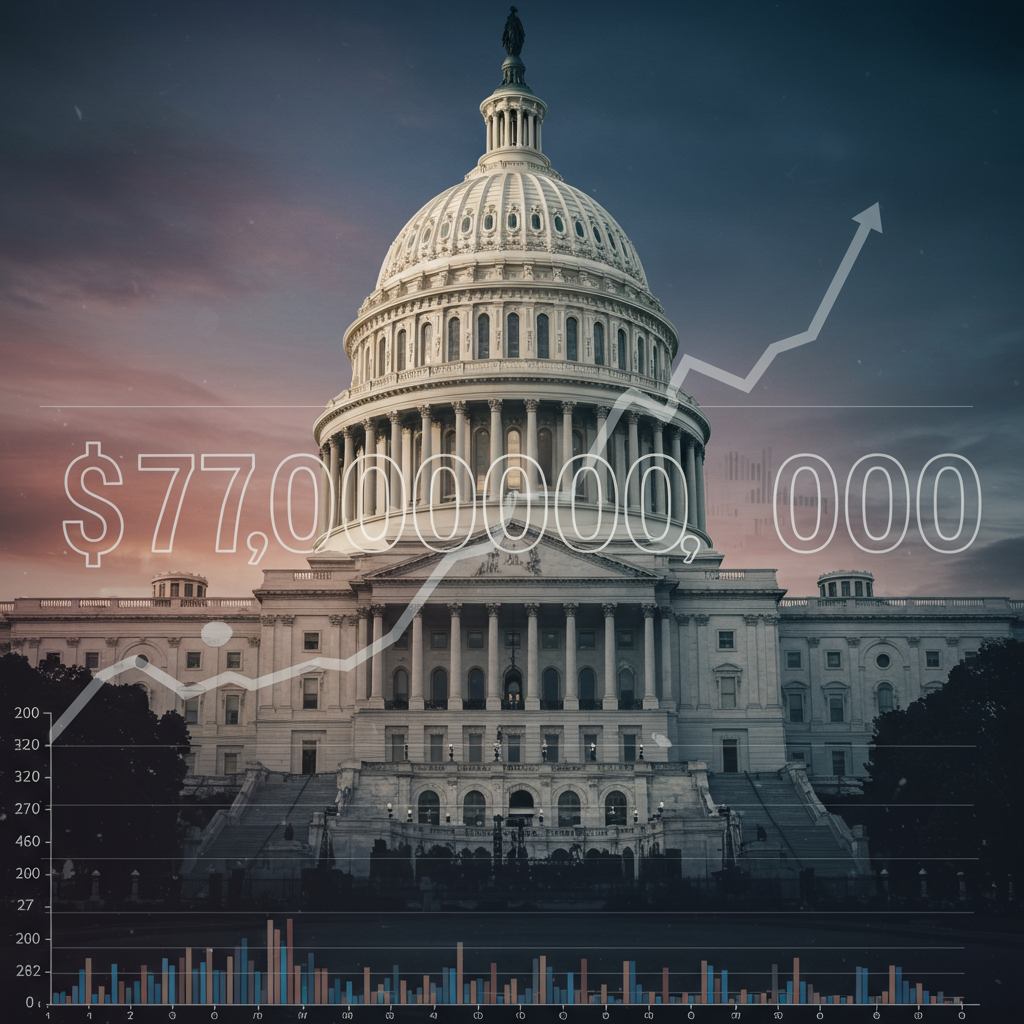The United States government‘s national debt has surged to an unprecedented $37 trillion. This colossal figure stands as a stark marker in the nation’s financial landscape. For many, it prompts a fundamental question: should we be genuinely concerned about the scale and future implications of this borrowing?
Recent legislative action has thrust this issue back into the spotlight. Following the passage of major budget legislation, projections indicate trillions more will be added to the existing debt pile in the coming years. This trajectory has reignited long-standing debates among economists, politicians, and financial experts about the sustainability of America’s fiscal path.
The Soaring Numbers: Understanding $37 Trillion
Putting $37 trillion into perspective is challenging. Visualizing it is difficult; for example, saving a million dollars every single day would take approximately 100,000 years to reach that sum. However, economists typically assess government debt not in isolation, but relative to the size of the economy that supports it.
The US economy generates an annual income, or Gross Domestic Product (GDP), of roughly $25 trillion. Viewed this way, the US national debt is significantly larger than its annual economic output. while the United States possesses the world’s largest and most innovative economy, providing a strong base, its debt-to-GDP ratio is considerably higher than many other developed nations. However, it’s worth noting that countries like Japan and Italy currently have even higher ratios.
How the Recent Budget Bill Adds to the Debt
The passage of recent comprehensive legislation, referred to by some as a “big, beautiful bill,” directly contributes to the projected increase in the national debt US. This legislation includes provisions designed to extend tax cuts initially enacted in 2017, effectively making them permanent. While proponents argue this stimulates economic growth, permanently lower tax revenues mean the government collects less income without corresponding spending cuts.
Furthermore, the bill allocates significant funding to various government priorities. While some spending reductions are included, the overall package increases outlays in key areas like defense and border security. The Congressional Budget Office (CBO), a non-partisan scorekeeper, estimated this specific bill could add around $2.4 trillion to the debt over the next decade. This contrasts with higher figures cited by some critics, including tech entrepreneur Elon Musk, who called the bill a “disgusting abomination” and warned of a much larger increase, though his specific numbers were contested.
The Core Problem: Spending Outstrips Revenue
At its heart, the reason the US national debt continues to grow is simple: the government consistently spends more money than it takes in through taxes and other revenues. This annual shortfall is known as the budget deficit. When a government runs a deficit, it must borrow money to cover the difference. This borrowing adds to the cumulative total of the national debt.
The current political climate, as reflected in the recent budget bill, leans towards both maintaining substantial spending and extending significant tax relief. While some spending was cut, the tax reductions were more impactful on revenue. This specific combination inherently drives up the budget deficit, accelerating the pace at which debt accumulates.
Market Signals Hint at Growing Concerns
The sheer scale of borrowing and the trajectory of the US debt are not going unnoticed by global financial markets. Doubts about the long-term sustainability of US borrowing are beginning to manifest in tangible ways.
One key signal is the value of the US dollar. The dollar has shown weakness against major currencies like the British pound and the euro, falling by 10% and 15% respectively since the beginning of the year. While multiple factors influence currency exchange rates, concerns over the reliability of the borrower can impact demand for its currency.
Another crucial indicator is the interest rate investors demand to lend money to the US government by buying its bonds. While overall borrowing costs have remained relatively stable, a specific market phenomenon known as the yield curve has signaled increased unease. The yield curve plots interest rates for bonds of different maturities. A “steepening” or “increasing” yield curve, where long-term rates rise faster or are significantly higher than short-term rates, often indicates that investors perceive greater risk in holding debt over longer periods. This suggests growing doubt about the long-term health of government finances. This market reaction occurs despite the fact that the US Federal Reserve has raised interest rates more slowly than central banks in Europe, a move that would typically strengthen the dollar by offering higher returns on dollar-denominated assets.
Expert Warnings: Is This an Inflection Point?
Prominent figures in the financial world are vocal about the potential risks. Ray Dalio, the founder of Bridgewater Associates, the world’s largest hedge fund, believes that US borrowing has reached a critical juncture, an “inflection point.”
Dalio’s analysis suggests that on the current path of spending and borrowing, the US could soon be dedicating an enormous sum – an estimated $10 trillion annually – just to service its existing loans and pay interest. He warns starkly that if the situation is “not dealt with now,” the debt could escalate to levels that become “unmanageable without great trauma.”
Dalio proposes concrete steps to avert such a crisis, suggesting the budget deficit needs to be significantly reduced relatively quickly. He points to the current deficit, estimated around 6% of GDP, and argues it should be brought down to closer to 3% soon. However, as demonstrated by the recent passage of legislation that increases borrowing, the current political direction appears to be moving away from this recommended fiscal tightening.
Understanding the Potential “Trauma” Scenarios
If the US debt situation were to spiral into an unmanageable crisis, what form might the “great trauma” take? Experts outline several potential, albeit drastic, scenarios:
- Austerity Measures: This involves painful fiscal adjustments. The government would have to implement drastic reductions in spending across various sectors, significantly increase taxes on individuals and corporations, or employ a severe combination of both. Such measures could trigger economic slowdowns or recessions and cause widespread hardship.
- Monetary Easing (Printing Money): The US central bank (the Federal Reserve) could step in, as it did after the 2008 financial crisis, by creating new money and using it to buy large amounts of government debt. This action effectively finances the government’s borrowing directly. However, this carries significant risks. It can fuel rapid inflation, eroding the purchasing power of money. It can also exacerbate inequality, as asset owners (like those with stocks or real estate) often benefit more than those who rely on wages.
- Default: The most extreme and arguably least likely scenario is a straightforward default, where the US government simply declares it cannot or will not pay its debt obligations. Given that the “full faith and credit of the US Treasury” is the bedrock upon which the entire global financial system is built, a US default would trigger an unprecedented global economic catastrophe. It would make the 2008 financial crisis, which was severe, seem minor by comparison.
Why a Crisis Isn’t Imminent (Yet): The Dollar’s Dominance
Despite the alarming numbers and expert warnings, most analysts currently view a near-term, catastrophic US financial crisis as unlikely. The primary reason, while not entirely comforting, is the unique position of the US dollar and US government bonds in the global financial system.
Simply put, the world has very few viable alternatives for large-scale investments, reserve holdings, and international trade settlement. As economist Mohamed El-Erian famously put it, the dollar is like your “cleanest dirty shirt” – nobody loves it perfectly, and many are trying to diversify away from it, but they are effectively forced to keep wearing it because the other options are less appealing or not available at the required scale.
While there has been a rise in interest in alternative assets like gold or other currencies such as the euro and the pound, moving trillions of dollars at scale is incredibly difficult without causing significant market disruption. This lack of viable alternatives grants the US a degree of leverage and stability, even with high debt levels.
High-Level Discussions and Ongoing Awareness
The significance of the US national debt and the status of the dollar are certainly not being ignored at the highest levels of global finance and government. Discussions are actively taking place among central bankers, finance ministers, and policymakers.
The Governor of the Bank of England, for instance, recently indicated that the levels of US debt and the dollar’s status are “very much on [US Treasury] Secretary Bessent’s mind.” He emphasized that while he didn’t see the dollar as “fundamentally under threat at the moment,” the US Treasury is “very aware of these issues” and does not underestimate their potential importance. This suggests that while immediate panic is absent, there is a clear recognition of the challenges ahead.
A Long-Standing Debate with No Divine Guarantee
Concerns about the sustainability of US borrowing and the future of the dollar’s global role are not new. A book titled “Death of the Dollar” was published as far back as 1968, warning of risks to its status as the world’s reserve currency. The author is long gone, but the dollar persists.
However, this historical persistence does not mean the dollar’s status or value is a divine right or inherently guaranteed forever. The current debt levels, coupled with the trajectory set by recent fiscal policies, underscore that maintaining confidence requires responsible management. While a sudden, catastrophic crisis might be averted by the dollar’s current dominance, the long-term risks outlined by experts remain pertinent. The debate over how to achieve fiscal sustainability, balance spending with revenue, and manage the growing debt will undoubtedly continue to be a central challenge for the United States. Navigating this complex financial landscape will require careful planning and difficult decisions to ensure future economic stability.
Frequently Asked Questions
How did the US national debt reach $37 trillion, and why is the recent budget bill controversial?
The US national debt has accumulated over decades as the government consistently spent more than it collected in revenue, creating annual budget deficits that required borrowing. The debt reached $37 trillion through a combination of long-term spending commitments (like Social Security, Medicare, defense) and responses to crises (like the 2008 financial crisis, the COVID-19 pandemic). The recent budget bill is controversial because it extends tax cuts enacted in 2017 and includes new spending, projected by the CBO to add trillions more to the debt over the next ten years, accelerating the debt’s growth trajectory.
What are the potential negative outcomes if the US national debt continues to grow unchecked?
If the US national debt continues to grow without a sustainable plan, potential negative outcomes, sometimes referred to as “trauma,” could include: Austerity measures requiring deep cuts to government services or significant tax increases; the central bank potentially resorting to printing money to buy debt, risking high inflation and increased economic inequality; or, in the most extreme scenario, a catastrophic default on debt obligations, which would destabilize the global financial system.
Despite high debt, why isn’t a US financial crisis considered imminent right now?
While concerns about the high US debt are valid, a major financial crisis is not seen as imminent primarily because the US dollar and US government bonds currently lack significant global alternatives. The dollar serves as the world’s primary reserve currency and is essential for international trade and finance. Although its dominance is debated, the scale required to shift away from dollar-denominated assets is immense, providing a degree of stability to the US position even with high debt levels. Experts note that while the situation is concerning, the immediate future is buffered by this lack of viable alternatives for global markets.




